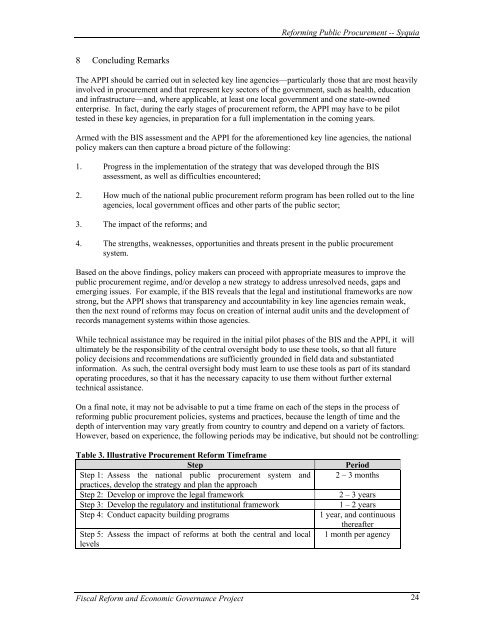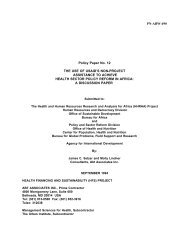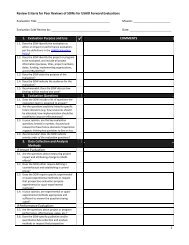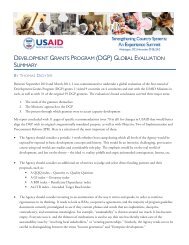Reforming Public Procurement in Emerging Market ... - KDID Portal
Reforming Public Procurement in Emerging Market ... - KDID Portal
Reforming Public Procurement in Emerging Market ... - KDID Portal
You also want an ePaper? Increase the reach of your titles
YUMPU automatically turns print PDFs into web optimized ePapers that Google loves.
<strong>Reform<strong>in</strong>g</strong> <strong>Public</strong> <strong>Procurement</strong> -- Syquia<br />
8 Conclud<strong>in</strong>g Remarks<br />
The APPI should be carried out <strong>in</strong> selected key l<strong>in</strong>e agencies—particularly those that are most heavily<br />
<strong>in</strong>volved <strong>in</strong> procurement and that represent key sectors of the government, such as health, education<br />
and <strong>in</strong>frastructure—and, where applicable, at least one local government and one state-owned<br />
enterprise. In fact, dur<strong>in</strong>g the early stages of procurement reform, the APPI may have to be pilot<br />
tested <strong>in</strong> these key agencies, <strong>in</strong> preparation for a full implementation <strong>in</strong> the com<strong>in</strong>g years.<br />
Armed with the BIS assessment and the APPI for the aforementioned key l<strong>in</strong>e agencies, the national<br />
policy makers can then capture a broad picture of the follow<strong>in</strong>g:<br />
1. Progress <strong>in</strong> the implementation of the strategy that was developed through the BIS<br />
assessment, as well as difficulties encountered;<br />
2. How much of the national public procurement reform program has been rolled out to the l<strong>in</strong>e<br />
agencies, local government offices and other parts of the public sector;<br />
3. The impact of the reforms; and<br />
4. The strengths, weaknesses, opportunities and threats present <strong>in</strong> the public procurement<br />
system.<br />
Based on the above f<strong>in</strong>d<strong>in</strong>gs, policy makers can proceed with appropriate measures to improve the<br />
public procurement regime, and/or develop a new strategy to address unresolved needs, gaps and<br />
emerg<strong>in</strong>g issues. For example, if the BIS reveals that the legal and <strong>in</strong>stitutional frameworks are now<br />
strong, but the APPI shows that transparency and accountability <strong>in</strong> key l<strong>in</strong>e agencies rema<strong>in</strong> weak,<br />
then the next round of reforms may focus on creation of <strong>in</strong>ternal audit units and the development of<br />
records management systems with<strong>in</strong> those agencies.<br />
While technical assistance may be required <strong>in</strong> the <strong>in</strong>itial pilot phases of the BIS and the APPI, it will<br />
ultimately be the responsibility of the central oversight body to use these tools, so that all future<br />
policy decisions and recommendations are sufficiently grounded <strong>in</strong> field data and substantiated<br />
<strong>in</strong>formation. As such, the central oversight body must learn to use these tools as part of its standard<br />
operat<strong>in</strong>g procedures, so that it has the necessary capacity to use them without further external<br />
technical assistance.<br />
On a f<strong>in</strong>al note, it may not be advisable to put a time frame on each of the steps <strong>in</strong> the process of<br />
reform<strong>in</strong>g public procurement policies, systems and practices, because the length of time and the<br />
depth of <strong>in</strong>tervention may vary greatly from country to country and depend on a variety of factors.<br />
However, based on experience, the follow<strong>in</strong>g periods may be <strong>in</strong>dicative, but should not be controll<strong>in</strong>g:<br />
Table 3. Illustrative <strong>Procurement</strong> Reform Timeframe<br />
Step<br />
Step 1: Assess the national public procurement system and<br />
practices, develop the strategy and plan the approach<br />
Step 2: Develop or improve the legal framework<br />
Step 3: Develop the regulatory and <strong>in</strong>stitutional framework<br />
Step 4: Conduct capacity build<strong>in</strong>g programs<br />
Step 5: Assess the impact of reforms at both the central and local<br />
levels<br />
Period<br />
2 – 3 months<br />
2 – 3 years<br />
1 – 2 years<br />
1 year, and cont<strong>in</strong>uous<br />
thereafter<br />
1 month per agency<br />
Fiscal Reform and Economic Governance Project 24







